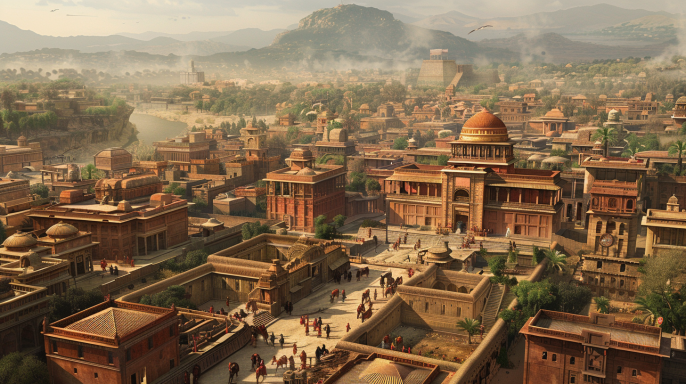Introduction
The Indus Valley Civilization, flourishing around 2500 BCE in what is now Pakistan and northwest India, was one of the world’s earliest urban cultures. Despite their advanced city planning and architecture, much about their society, including their writing system and reasons for decline, remains unknown. This article delves into the intriguing mysteries surrounding the Indus Valley Civilization.
Historical Background
The Indus Valley Civilization, also known as the Harappan Civilization, spanned the area around the Indus River. It was discovered in the early 20th century, with major excavations revealing the cities of Harappa and Mohenjo-Daro. These findings shed light on a sophisticated and advanced ancient society.
Urban Planning and Architecture
The Indus Valley cities are renowned for their meticulous planning and impressive architecture. They featured grid-patterned streets, advanced drainage systems, and well-constructed buildings. Mohenjo-Daro and Harappa stand out as prime examples of this urban sophistication.
Daily Life and Society
The social structure of the Indus Valley Civilization was complex and well-organized. The people engaged in farming, trading, and various crafts. Evidence suggests they had a thriving economy supported by trade with neighboring regions, including Mesopotamia.
Writing System
One of the greatest mysteries of the Indus Valley Civilization is their writing system. The script, found on seals and pottery, remains undeciphered despite numerous attempts by linguists and historians. This has left a significant gap in understanding their language and literature.
Technological and Agricultural Innovations
The Indus Valley people were skilled in various technologies, including irrigation and agriculture. They built sophisticated water management systems and were adept at crafting tools and ornaments. Their innovations in these fields were ahead of their time.
Religious and Cultural Practices
Religious and cultural artifacts, such as seals depicting deities and ritual objects, indicate a rich spiritual life. However, much about their religious beliefs and practices remains speculative due to the undeciphered script and lack of written records.
Theories of Decline
Several theories attempt to explain the decline of the Indus Valley Civilization. These include environmental changes like droughts and floods, shifts in river courses, and possible invasions. However, none of these theories provide a definitive answer.
Environmental Challenges
The civilization’s dependence on river systems made them vulnerable to climatic changes. Shifts in the monsoon patterns and tectonic activities could have caused significant disruptions, leading to their eventual decline.
Archaeological Discoveries
Ongoing excavations continue to uncover artifacts and structures, offering new insights into the Indus Valley Civilization. These discoveries help piece together aspects of their daily life, trade, and societal organization.
Mysteries and Unanswered Questions
Despite extensive research, many questions about the Indus Valley Civilization remain unanswered. The undeciphered script, the exact nature of their political system, and the reasons for their decline continue to intrigue scholars.
Cultural and Global Significance
The Indus Valley Civilization significantly influenced contemporary cultures in South Asia. Their advanced urban planning, technological innovations, and trade networks set the foundation for future civilizations in the region.
Comparisons with Other Ancient Civilizations
Compared to Mesopotamia and Egypt, the Indus Valley Civilization had unique features such as standardized weights and measures, and a lack of monumental architecture. These differences highlight their distinct development path.
Preservation Efforts
Preserving the archaeological sites of the Indus Valley Civilization poses challenges due to urbanization and environmental factors. Efforts are being made to protect and conserve these sites for future research and public education.
Visitor Experience
Visitors can explore several Indus Valley Civilization sites, such as Harappa and Mohenjo-Daro, which offer a glimpse into this ancient world. These sites provide educational tours and exhibits showcasing artifacts and historical context.
Modern Research and Future Prospects
Current archaeological projects employ advanced technologies like satellite imagery and ground-penetrating radar to uncover hidden sites and artifacts. Future discoveries may provide more answers about this enigmatic civilization.
Conclusion
The Indus Valley Civilization remains one of history’s most fascinating and mysterious ancient cultures. Their advanced urban planning, sophisticated technology, and rich cultural life continue to captivate researchers and the public. While many mysteries persist, ongoing research and discoveries keep the hope alive that one day we will fully understand this remarkable civilization.
FAQs
What was the Indus Valley Civilization?
The Indus Valley Civilization was an ancient urban culture that flourished around 2500 BCE in present-day Pakistan and northwest India, known for its advanced city planning and architecture.
Why is the Indus Valley Civilization important?
The Indus Valley Civilization is important because it was one of the world’s earliest urban cultures, contributing significantly to human history through its innovations in urban planning, technology, and trade.
What are the major cities of the Indus Valley Civilization?
The major cities of the Indus Valley Civilization include Mohenjo-Daro and Harappa, both known for their sophisticated layout and infrastructure.
Why can’t we read the Indus script?
The Indus script remains undeciphered because no bilingual texts have been found, and the script is not similar to any known writing systems, making it difficult for linguists to decode.
What caused the decline of the Indus Valley Civilization?
The exact cause of the decline is unknown, but theories include environmental changes, natural disasters, and invasions. The decline remains a topic of ongoing research and debate.

